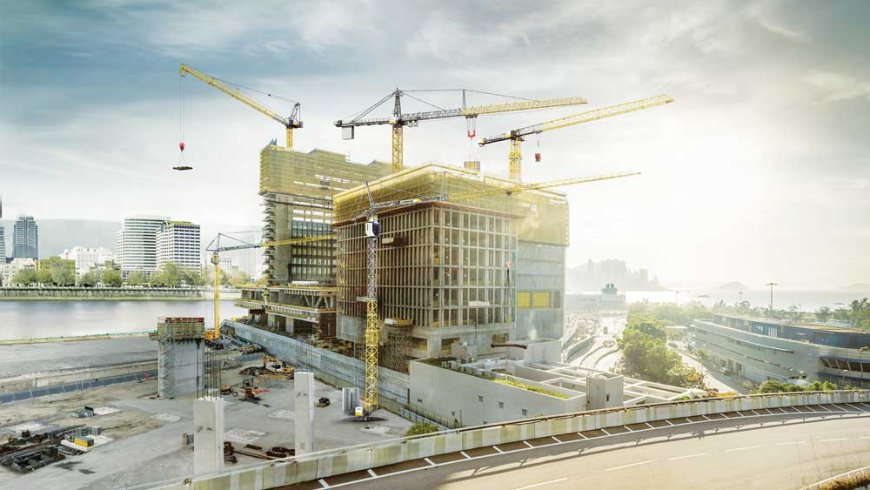Tower Cranes: Giants in the Construction Industry
In the world of modern construction, where skyscrapers pierce the skyline and ambitious architectural wonders rise from the ground, tower cranes stand tall as the unsung heroes that make these dreams a reality. These magnificent machines, reaching towards the heavens,

In the world of modern construction, where skyscrapers pierce the skyline and ambitious architectural wonders rise from the ground, tower cranes stand tall as the unsung heroes that make these dreams a reality. These magnificent machines, reaching towards the heavens, play a pivotal role in shaping our urban landscapes. Equipment Times delves into the fascinating world of tower cranes, exploring their capabilities and the crucial role they play in construction projects.
To understand the significance of tower cranes, we must journey back in time to ancient civilizations that first employed simple lifting mechanisms. From the Egyptians’ use of wooden ramps and pulleys to the Romans’ advanced cranes, the evolution of these machines paved the way for the modern tower crane. We’ll explore how tower cranes emerged as a solution to the growing demand for taller buildings and more efficient construction methods.
Anatomy and Design
Tower cranes are a masterful blend of engineering precision and sheer power. This section will delve into the intricate design elements that make these machines capable of lifting heavy loads to astonishing heights. From their towering steel lattice structures to counterweights, jibs, and trolleys, we’ll break down the components and highlight the role each one plays in the crane’s operation.
Lifting the Sky
Tower cranes are the muscle behind the construction industry, responsible for lifting and transporting heavy materials, equipment, and even personnel to great heights. We’ll explore the immense lifting capacities of these machines, which can hoist multiple tons of materials with remarkable accuracy and efficiency. We’ll also discuss the various types of loads they handle, ranging from steel beams and concrete slabs to prefabricated modules.
Tower Crane Operators
Behind every tower crane, there is a skilled operator who maneuvers these colossal machines with precision and expertise. This section will shed light on the crucial role played by operators, exploring their training, responsibilities, and the challenges they face while operating hundreds of feet above the ground. We’ll also highlight the advanced technologies and safety measures that assist operators in their daily tasks.
Tower Cranes in the Future
As construction techniques and architectural designs evolve, tower cranes continue to adapt and push boundaries. This section will explore the future of tower crane technology, including advancements in automation, remote operation, and safety features. We’ll discuss how these innovations are transforming the construction industry, making projects more efficient, cost-effective, and environmentally friendly.
Tower cranes are awe-inspiring machines that defy gravity, lifting structures to new heights and shaping the skylines of our cities. From their humble beginnings to their current state-of-the-art designs, these mechanical marvels have revolutionized the construction industry. As we look to the future, the evolution of tower cranes promises to bring even greater efficiency, safety, and versatility to construction sites around the world. So, the next time you marvel at a towering skyscraper, take a moment to appreciate the towering cranes that made it possible.
Indian Market
India, a country known for its rapid urbanization and ambitious infrastructure projects, has witnessed a significant surge in the demand for tower cranes. As the construction industry continues to flourish, these towering machines have become a ubiquitous presence on India’s skyline. This feature story will explore the Indian market for tower cranes, highlighting its growth, key players, challenges, and the pivotal role these cranes play in shaping the nation’s built environment.
Growing Demand for Tower Cranes in India
India’s booming population, rapid urbanization, and ambitious infrastructure development plans have fueled the demand for high-rise buildings, bridges, and mega-projects. This section will delve into the factors driving the increased demand for tower cranes, such as urban expansion, the rise of smart cities, and the government’s focus on infrastructure development.
Market Overview and Key Players
India’s tower crane market is witnessing intense competition as both domestic and international manufacturers strive to cater to the growing demand. This section will provide an overview of the market landscape, highlighting key players, their market share, and the range of tower crane models they offer. We’ll also explore the factors that influence customers’ choices, including price, quality, after-sales service, and technological advancements.
Infrastructure and Construction Projects
India’s ambitious infrastructure development projects, such as metro rail networks, airports, highways, and residential complexes, are driving the need for tower cranes. This section will focus on some of the iconic projects where tower cranes have played a crucial role in their construction. We’ll also discuss how these projects contribute to economic growth and employment generation.
Challenges and Opportunities
Despite the market’s growth potential, the Indian tower crane industry faces several challenges. This section will discuss the obstacles hindering market expansion, such as regulatory complexities, lack of skilled labor, and the need for improved safety standards. Additionally, we’ll highlight the opportunities that arise from addressing these challenges, including technology adoption, skill development programs, and collaborations between industry stakeholders.
Future Outlook and Emerging Trends
The Indian market for tower cranes is poised for continued growth and innovation. This section will explore the future outlook, including projected market trends, emerging technologies, and the impact of sustainable construction practices. We’ll also discuss how advancements in automation, telematics, and safety features are shaping the industry, making construction sites more efficient and safer.
Hits: 25








